Blastocyst
In the past most embryos produced with IVF were transferred on day three of development, known as cleavage stage. When an embryo reaches five days of development it is called a blastocyst. Currently, with advances in understanding of the needs of developing embryos, the ability to produce blastocysts in the laboratory has increased. This extended culture time allows nature to help select those embryos with the highest capacity to produce a pregnancy. Culturing and transferring blastocysts on day five of development allows the transfer of fewer embryos while still maintaining a high pregnancy rate. Normally only two blastocyst stage embryos are transferred, thus reducing the risk of multiple pregnancies not higher than twins.
WHAT IS BLASTOCYST?
- Part of IVF Process when fertilized egg (Embryo) reaches five days of development is called blastocyst.
- The extended culture time allows the selected embryo to give good pregnancy rate.
WHO QUALIFIES FOR BLASTOCYST CULTURE?
- Women at least with few good quality embryos on day 3 after egg collection will have chance of blastocyst transfer.
- Couples who have undergone repeated failed IVF are also candidates for the blastocyst transfer.
- For young women having good prognosis. However it is suitable for women of all age groups.
- Specially women over 40 years can also benefit and pregnancy rates are high if their embryos are suitable for this procedure.
NATURE’S SELECTION OF BEST EMBRYO
- The slow and poor embryo stops and embryos of good quality go on to day 5 blastocyst stage.This is the nature s selection of best embryos.
- Later best 2 embryos are transferred in to the uterus to achieve pregnancy. 70 – 80 % of pregnancy rate at Prashanth Fertility Research Centre is due to the fact that we are specialized in blastocyst transfer with new specialized embryo scope.




